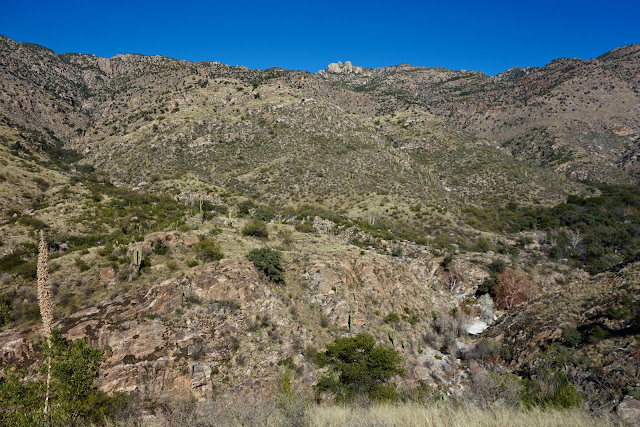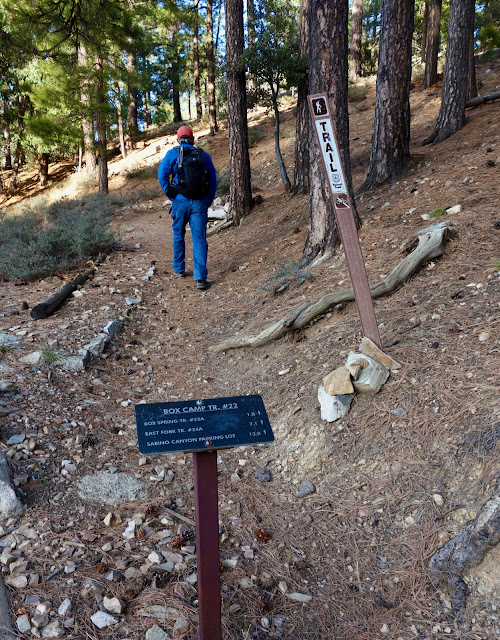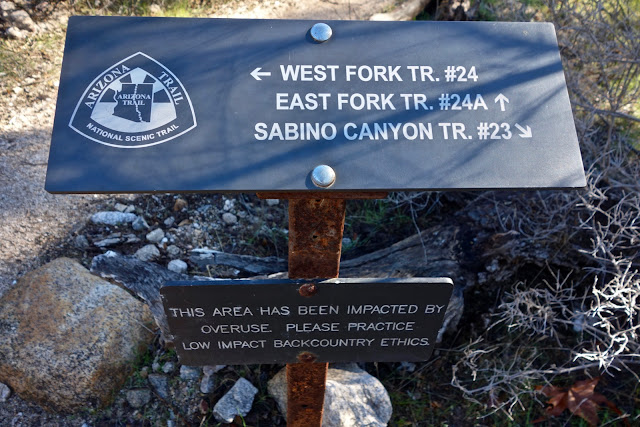Travel: Shuttle required. Drop a vehicle at Sabino Canyon Recreation Area or Gordon Hirabayashi Trailhead and drive to the BCT Trailhead. The shuttle from Sabino is longer but the hike is less demanding.
Sabino Canyon Recreation Area: Located at the northeast corner of Sunrise Drive and Sabino Canyon Road in Tucson. The parking lot fills on weekends so arrive early. Overflow parking is half a mile north of the main entrance. Show your Coronado Recreation Pass, National Parks Pass, or pay the day-use fee. Tram and fee information.
Gordon Hirabayashi Trailhead and Campground: In Tucson, drive east on Tanque Verde Road and turn left on the Catalina (Mount Lemmon) Highway. Drive past Molino Basin and turn left at mile marker 7.3 at the sign for Gordon Hirabayashi Recreation Area, FSR 807. Drive through the shaded campground on a dirt road (tables, fire grates, food boxes, pit toilets, trash, no water) and park at the trailhead in 0.2 mile.
BCT Trailhead: On the Catalina Highway, pass by the Palisade Visitor Center and begin a downhill stretch. The signed trailhead is on the left just past Spencer Canyon Campground, mile marker 21.4. The lot holds a dozen cars. No facilities, no fees, no water, no dogs.
Distance and Elevation Gain: BCT Trailhead to the East Fork Trail is 7.1 miles with 150 feet of climbing and 4,450 feet of descent. Sabino Canyon Trail to Tram Stop #9: 2.7 miles, 100 feet of vertical. Add 3.8 miles if you walk down the park road. Hirabayashi Trailhead: 5.7 miles, 1,600 feet of climbing
Total Time: 5:00 to 8:00 depending on exit route.
Difficulty: Trail; navigation moderate; no exposure; hike on a cool day (winter months); all streams are ephemeral and Apache Spring is not reliable so carry all the water you will need.
Maps: Mount Bigelow; Mt. Lemmon; Sabino Canyon; Agua Caliente Hill, Arizona 7.5' USGS Quads, or Pusch Ridge Wilderness, Coronado National Forest, USDA Forest Service, 1:24,000
Date Hiked: March 7, 2020
References: The Santa Catalina Mountains, by Pete Cowgill and Eber Glendening, 1997.
"A Guide to the Geology of the Santa Catalina Mountains, Arizona: The geology and life zones of a Madrean Sky Island." Arizona Geological Survey, Down-to-Earth, #22, by John V. Bezy, 2016.
Quote: Certain trails are so elegant that they seem to lie sleeping just beneath the surface of the earth. Rather than being created by us, it is as if these trails unveil themselves through us. Robert Moor, On Trails
From the overlook above the confluence of the three forks of Sabino Canyon, Box Camp Canyon is image-left and Palisade Canyon is on the right. After passing Apache Spring, the trail descends along the east rim of Box Camp Canyon before working its way over to the ridge just west of Palisade.
Route: For legibility, the hike is split between two maps. The first map shows the route bearing southwest from the BCT Trailhead to Apache Spring. The blue-line represents an optional side trip to Spencer Peak and the red-line is the side trip to Box Camp and Box Spring. Note: There is universal agreement that Apache Spring was incorrectly placed on the Mt. Lemmon topo. I have corrected the error. Also, the trail has been rerouted significantly since the topo was published in 1981. The black-line route is accurate for today's trail. The trail has a reputation for being hard to follow so we first hiked uphill from Sabino Canyon to Apache Spring. Next, we hiked downhill from the BCT Trailhead to the Hirabayashi Trailhead. The trail is clear in all but two places which will be discussed.
This map shows the lower part of the BCT and the two exit options. Sabino Canyon is the red-line and Hirabayashi is the purple-line route. Before realignment the BCT followed the east rim of Box Camp Canyon to the floor of the East Fork. Today, the junction of the three trails is further east of Box Camp Canyon. Take note if you are hiking uphill.
Box Camp Trail #22 to Box Spring Trail, 1.8 miles
Spencer Peak, 8,206', Side Trip
For those who can't pass beneath a nearby mountaintop, the optional side trip adds a mere 0.4 mile roundtrip and 200 feet of climbing. Watch for a singletrack branching right 400 feet from the trailhead. Walk under electric lines and weave around graythorn and deadfall to the crest. It's a nice little spot with openings in the forest to Radio Ridge and Mount Wrightson.
We saw two sets of cougar tracks at different elevations. (THW, photo)
Descend through a peaceful park with huge spaces between and beyond the trees. (THW, photo)
The footpath rolls off the ridge to the north and crosses the "Northwest Fork" of Palisade Canyon. The trail more or less follows this gorgeous stone watercourse all the way to Apache Spring. The only perennial streams on the Catalina front are Sabino and Lemmon Canyons. The channel drops, rocks step down, and water spills in small cascades.
Pass a venerable, double-trunk alligator juniper while descending into drier habitat with Arizona oak, Mexican piñon, Schott's yucca, and agave. Crews had been out recently cutting graythorn away from the trail and creating stylized water bars. Pass by veins of quartz and banded gneiss.
At 1.8 miles, 7,520 feet, Box Spring Trail #22A branches right at a cairn. Thinking there would be a sign we blew right by the turnoff and had to climb back. (In 2021 the cairn was gone.)
Box Camp and Box Spring Side Trip
Box Camp is 0.1 mile roundtrip and Box Spring is 0.6 mile out-and-back with a net loss of 300 feet.
Cowgill and Glendening write that Box Camp was named by early trail users who nailed boxes to trees for storage of food and other goods on trips into the high country. It is located on a large, pleasant flat with big views through the trees. (THW, photo)
We set off to find the spring that presumably supplied water for those in camp. The trail has fallen into disuse and is a tangled mess with deadfall and snarled brush, shown. Cross the Northwest Fork, ascend to the low ridge east of Point 7,523', and then plummet down the east wall of Sabino Canyon. Even in a wet year the small seep at 7,260 feet, yielded maybe enough water for a desperate party of one.
Box Spring Trail to Apache Spring, 2.3 miles
Box Camp is the turn around for casual hikers. The trail plunges and pines are replaced by madrone, oak, yucca, and manzanita. The well-cairned path is clear but needs clipping; wear long pants. When granite disintegrates, sharp-edged feldspar and quartz crystals contribute to the granular gravel (Bezy). The trail surface is slippery when steep.
At 7,200 feet, take a few steps off the trail to a lookout with Tucson and an immense span of Southern Arizona spread out below. This promontory marks the beginning of the open ridge section of the hike that extends nearly to Apache Spring. Thimble Peak, Saddleback Ridge, and Blackett's Ridge will be prominent in the view corridor all the way down the trail.
The impressive ridge to the southwest begins in Sabino Canyon, climbs to McFall Crags, goes up and over Rattlesnake Peak, and concludes with Cathedral Rock. (THW, photo)
The trail lies on the divide between the headwaters of Box Camp Canyon and the tower-filled tributaries of Palisade Canyon. Southeast is the triumvirate of the Rincon Mountain Sky Island: Mica Mountain, Rincon Peak, and Tanque Verde Peak.
The elongated and airy ridge is the scenic highlight of the BCT. (THW, photo)
At 6,680 feet, the trail has been re-routed off the ridge to the west. It leaves the ridge at a distinctive, stacked hoodoo that sits out in the open. Immediately after passing a large outcrop, the trail does an eastward lateral and returns to the ridge. In 2020, the trail was overgrown so scout around for it. This image looks up at the hoodoo, image-center, and the gargoyle outcrop.
At 6,100 feet, Arizona oaks take hold, typical of the Evergreen Woodland life zone. Manzanita was blooming in winter (watch out for the bees!) and beargrass was prevalent.
We knew that the location of Apache Spring on the Mt. Lemmon topo was in error but we left the trail anyway to explore at 5,940 feet. This is the location of a significant trail reroute and there was no sign of the old track. We hunted around on the Northwest Fork and ruled out the existence of a spring. The granite-floored streambed is beautiful and there are a few small waterfalls and pools. (THW, photo)
Apache Spring is at the base of the small ridge capped with standing rocks, image-center.
Arrive at Apache Spring at 4.1 miles, 5,550 feet. The spring is but a seep in the stone-walled corridor and typically runs after summer rains and snow melt. On our two winter visits it was impossible to distinguish the spring from the waters of the Northwest Fork. (THW, photo)
Apache Spring to East Fork Trail, 3 miles
The BCT abandons the Northwest Fork which plunges to its confluence with Palisade. The path passes north of the standing rock ridge and then enters the Box Camp Canyon drainage. The trail works the east slope for almost 1,200 feet of descent. The hiker is completely engulfed in free-standing rock stacks, balanced rocks, and effigies. This is hoodoo country at its best. Below is an example of case hardened rock varnish on granite.
Stone pillars are within the Box Camp Canyon headwater bowl and all along its rim.
On the floor of the bowl is vegetation typical of Semi-Desert Grassland: shindagger, sotol, pricklypear, resurrection plant, and rabbitbrush. Blooming in March were deervetch, Santa Catalina prairie clover, desert anemone, wild hyacinth, and verbena.
The trail makes a couple of long lazy switchbacks The path is more obscure in the grass so have some awareness. At 5,200 feet, make a final hook and contour southeast on a three-foot-wide grass shelf back to the Box Camp Canyon east rim. This image looks back at the snaggletooth ridgetop the trail was bypassing.
Look over into Palisade Canyon named for the series of waterfalls plummeting over vertical drops.
The BCT descends on the ridge to 4,400 feet and then does a 90 degree turn and leaves the east rim for good. The turning point is one of the best vistas along the trail. Below, the East Fork Trail is visible as well as Sabino Canyon Trail, image-right.
The trail heads east to link with the soft ridge just west of Palisade Canyon. On the way, it drops into a small drainage, tracks along the watercourse briefly (squishy wet in January), and then bears southeast toward the ridge. In this area we saw a white-tailed deer and brilliant pink Parry's beardtongue. (THW, photo)
On both of our hikes we lost track of the trail at 4,220 feet. There are loose ends in the grass from other hikers wandering around. If you become confused do not be tempted to go down the draw. Instead walk eastward to the ridge. From there, the trail makes tight switchbacks down the gentle broad ridge all the way to the East Fork of Sabino.
Enter the familiar land of Sonoran Desert Scrub. There is a robust population of saguaro, barrel cactus, pricklypear, mammillaria, ocotillo, jojoba, palo verde, acacia, creosote bush, agave, and bursage. Mexican poppies, scorpionweed, and fairyduster were blooming in March. Shining crystals lay on the ground where a black-necked garter snake slithered out of sight. A golden eagle circled in the gentle lift. Walk through a thick and towering staghorn cholla forest.
Within 50 yards of the East Fork is a bright, winter-green forested haven with Arizona oak, black oak, alligator juniper, and sycamore.
Cross the East Fork of Sabino Canyon on boulders at 3,720 feet. On both of our visits the water was running swiftly but the channel is dry most of the year. It is just a few more strides to the end of the Box Camp Trail at its junction with the East Fork Trail at 7.1 miles. (THW, photo)
The landscape is starkly different on the Sabino Canyon Trail compared with the East Fork Trail to Hirabayashi Trailhead. The effort differs considerably as well.
To Sabino Canyon Recreation Area, Tram Stop #9: 2.7 miles, 100 feet of elevation gain
From the junction of the Box Camp and East Fork Trails, turn right. Walk 0.1 mile to the signed junction where the West Fork, East Fork, and Sabino Canyon Trails converge. Turn left on Sabino Canyon Trail.
Bust up a short incline and walk a few paces out to a promontory. From there you can study the route of the BCT below Apache Spring. Box Camp Canyon joins the East Fork just before its confluence with the West Fork and Sabino Canyon.
The trail zigzags in and out of scallops on Sabino Canyon's east wall, contouring at 3,700 feet. The trail is smooth and fast. This remarkable passage has views extending from Mount Lemmon down into the constricted gneiss gorge. Round a corner and see Sabino Canyon Road and the Phoneline Trail under Thimble Peak. (THW, photo)
Descend the last 400 feet on switchbacks to the pavement at Shuttle Stop #9, elevation 3,334 feet. See the link at the top of this post for tram and fee information. Alternatively, it is 3.8 pleasant miles down the paved road to the visitor center and parking lot. There are bathrooms and drinking faucets at some of the shuttle stops, including Stop 8.
To Hirabayashi Trailhead: 5.7 miles, 1,600 feet of climbing
At the junction of the Box Canyon and East Fork Trails, turn left. The rest of the hike is on a section of the Arizona Trail. The trail makes two climbs. The first is to the saddle, shown, on the divide separating the East Fork and Sycamore Canyons. The treadway has a gentle grade and trampled clarity.
The Palisades Trail turns off at 8.1 miles. It heads uphill to meet the Catalina Highway near the Palisades Visitor Center. On top of the divide, 9.1 miles, 4,580 feet, go left onto the Sycamore Reservoir Trail. Shreve Saddle, the next climb, is on the east side of Gibbon Mountain, shown. In 0.1 mile, cross Sycamore Canyon creek and follow it all the way to the confluence with Bear Canyon.
Take a spur trail to the dam built in the 1930's, 10.4 miles. The reservoir, pinched by the walls of Bear Canyon, is now filled with sand and silt but stone and cement structures, and sections of the water line remain.
Back on the Arizona Trail, the footpath kicks uphill to the top of a rise where an old road branches left. It looks like a shortcut to Shreve Saddle but it is more difficult than the trail. To the east is the multi-tiered Mount Lemmon Highway. Windy Point is located on the upper road wrap on the prominence, image-center-left. In the center is Seven Cataracts Vista and on the right is the Thimble Vista pullout.
The 600 foot ascent to Shreve Saddle is on a classic trail built long ago with interspersed staircases to manage the grade. Half hidden in the brush are historic stone pillars that once supported the water line running from the reservoir to the prison camp.
Pass out of the Pusch Ridge Wilderness at Shreve Saddle, elevation 5,020 feet, 11.8 miles. It is located on the divide between Bear and Soldier Canyons. Descend gently through open grassland slipping in and out of the stone-dry upper Soldier Canyon waterway.
Molino Junction, 12.7 miles, is the location of the now abandoned Federal Prison Camp. Prisoners labored to build the Mount Lemmon Highway. During World War II, some of the prisoners were conscientious objectors. In 1942, Dr. Gordon Hirabayashi challenged the constitutionality of incarcerating Japanese Americans following the attack on Pearl Harbor in 1941. He was convicted and sentenced to serve at the prison camp now named in his honor. Structures have been removed but some foundations remain. Walk up one last little rise and you're at the trailhead.






































6 comments:
I understand that Box Camp Trail is no longer maintained. I haven't tried this trail yet, but I'll probably do Palisades Trail first and see what that looks like. I have done Gordon Hirabiyashi to both Sabino Canyon and Bear Canyon, and both are lovely. (Bear is slightly nicer.)
Hi Larry, I truly hope the Forest Service continues to maintain the historic Box Camp Trail. The Palisades Trail is on my wish list. If you like it, please leave a comment. Debra
I just did a very short part of the top of Box Camp, and it was fine. The tricky part is supposed to be below that, though.
Maybe we can do Palisades together sometime.
Palisades, sure late fall or early winter. Debra
I just heard that Box Camp has been cleaned up. Some hikers I know say there are cairns and ribbons now, not too bad.
Thanks Larry, great news. I love that trail! We'll hold off on Palisades until spring when the falls are running. Debra
Post a Comment